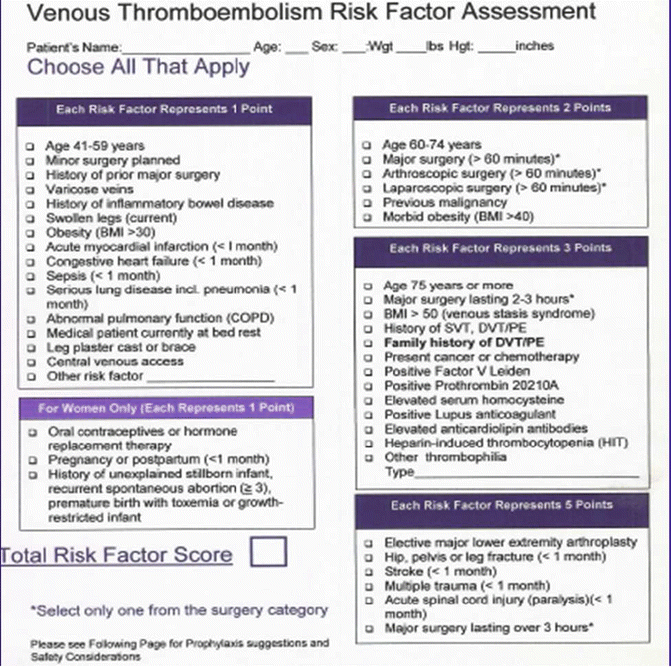Fig. 37.1
ASPS VTE task force assessment and prevention recommendations
There is a larger body of literature in other surgical specialties that have investigated the timing of chemoprophylaxis. In procedures that are moderate to high risk for VTE, preoperative chemoprophylaxis with LMWH has shown to have a marked decrease in DVT/PE without any increase in major bleeding complications in both orthopedic surgery and surgical oncology [4, 13, 14]. Although this has not been fully investigated in the plastic surgery literature, the authors’ institution adopted a protocol for preoperative chemoprophylaxis based on the existent surgical literature. Originally this consisted of 5000 units of subcutaneous unfractionated heparin given in preoperative holding within 60 min of induction of anesthesia. In the face of increased evidence showing increased efficacy of extended protocols with LMWH, we expanded our protocol to consist of enoxaparin 40 mg SQ on call to the OR and then continued daily for 2 days. Our initial publication based on this protocol did not show an increase in bleeding complications, and there were no VTE in the series which included 151 patients. This data set included 60 % of patients who also underwent another combined body-contouring procedure at the same time (i.e., lower body lift, breast reduction, etc.) (Tables 37.1 and 37.2) [22].
Table 37.1
Summary of complications
n | Overall complications | Cellulitis | Seroma | Hematoma | Minor wound dehiscence | Reoperationa | VTE | Blood transfusion | |
|---|---|---|---|---|---|---|---|---|---|
Heparin/SCD | 101 | 19(19 %) | 5(10 %) | 4(8 %) | 1(1 %) | 2(2 %) | 2(2 %) | 0(0 %) | 0(0 %) |
Enoxaparin | 50 | 7(14 %) | 3(6 %) | 1(2 %) | 0 | 3(6 %) | 1(2 %) | 0(0 %) | 0(0 %) |
Table 37.2
Operative characteristics
Variable | Heparin group | Enoxaparin group | P value |
|---|---|---|---|
n = 101 | n = 50 | ||
Abdominoplasty alone | 23 | 12 | 1.0 |
Abdominoplasty with flank/abdominal liposuction | 18 | 8 | 1.0 |
Abdominoplasty with other non-abdominal procedure | 60 | 30 | 1.0 |
37.3 Discussion
The use of chemoprophylaxis in plastic surgery patients and in particular in body-contouring surgery has drawn increased attention over the course of the last decade. Despite the increased interest in this area, the body of literature in plastic surgery is still sparse. There is a fair amount of literature in other surgical specialties to support the use of preoperative chemoprophylaxis and specifically the use of enoxaparin in the perioperative period [4, 13, 14]. To date there have been no randomized controlled trials of chemoprophylaxis in plastic and reconstructive surgery patients. It is because of this that most published recommendations apply indirect evidence from other surgical patients (general and mixed surgical patients). There are several compelling retrospective studies on perioperative chemoprophylaxis in body contouring and abdominoplasty specifically [5, 7, 9, 11, 12, 16–18, 22]. The majority of these focus on postoperative chemoprophylaxis. The Caprini risk assessment model has now been validated in plastic surgery patients in general and specifically in post-bariatric body-contouring patients. This is the focus of most current recommendations. Despite the increasing evidence of the importance of chemical VTE prophylaxis, the plastic surgery community as a whole has not embraced this idea. Several national surveys have been conducted and the rate of chemoprophylaxis, even in high-risk groups is unacceptably low [10–12]. The most common reason cited in these studies is the perceived risk of bleeding complications, both major and minor.
Based on the authors’ experience and the breadth of evidence in other surgical specialties, it is felt that the time the patient is under general anesthesia and immediately following is the most crucial. It is during this time of maximum immobility (stasis) following surgery (hypercoagulability and endothelial injury) that the patient is at greatest risk [3, 14




Stay updated, free articles. Join our Telegram channel

Full access? Get Clinical Tree








